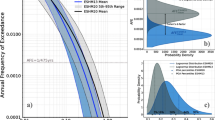Abstract
The present state-of-the-art for natech risk and management is discussed. Examples of recent natechs include catastrophic oil spills associated with Hurricane Katrina and hazardous chemical releases in Europe during the heavy floods of 2002. Natechs create difficult challenges for emergency responders due to the geographical extent of the natural disaster, the likelihood of simultaneous releases, emergency personnel being preoccupied with response to the natural disaster, mitigation measures failing due to the effects of the natural disaster, and others. Recovery from natechs may be much more difficult than for “normal” chemical accidents, as the economic and social conditions of the industrial facility and the surrounding community may have been drastically altered by the natural disaster. Potential safeguards against natechs include adoption of stricter design criteria, chemical process safeguards, community land use planning, disaster mitigation and response planning, and sustainable industrial processes, but these safeguards are only sporadically applied. Ultimately, the public must engage in a comprehensive discussion of acceptable risks for natechs.


Similar content being viewed by others
Notes
The Disaster Mitigation Act of 2000 requires that state and local governments prepare disaster mitigation plans in order to be eligible for Federal mitigation funds.
References
American Society of Civil Engineers (2002) Minimum design loads for buildings and other structures. ASCE 7-02, Reston, Virginia
Antonioni G, Spadoni G, Cozzani V (2007) A methodology for the quantitative risk assessment of major accidents triggered by seismic events. J Hazard Mater 147(1–2):48–59
BP U.S. Refineries Independent Safety Review Panel (2007) Available on the US Chemical Safety and Hazard Investigation Board website: http://www.csb.gov/completed_investigations/docs/Baker_panel_report.pdf, accessed March 2, 2007
Brown M (2005) St. Bernard oil spill is wider than was thought. Times-Picayune, New Orleans, Louisiana, December 6, 2005
California Office of Emergency Services (1998) California accidental release prevention program. Final regulations. California Code of Regulations, Title 19, Division 2, Chapter 4.5. Governor’s Office of Emergency Services
Cruz AM, Steinberg LJ (2005) Industry preparedness for hazardous materials accidents during the Kocaeli earthquake. Earthq Spectra 21(2):285–304
Cruz AM, Laura JS, Vetere-Arellano AL (2006) Emerging issues in natech disaster risk management in Europe. J Risk Res 9(5):483–501
European Commission (2002) Floods in Czech Republic. Information Sheet No. 5, Directorate General Environment, Civil Protection Unit, Brussels
Fabbrocino G, Iervolino I, Orlando F, Salzano E (2005) Quantitative risk analysis of oil storage facilities in seismic areas. J Hazard Mater 123:61–29
Haddow GD, Bullock JA (2003) Introduction to emergency management. Butterworth-Heinemann, Amsterdam
International Building Code (2006) International Code Council, Washington DC
Knutson TR, Tuleya RE (2004) Impact of CO2-induced warming on simulated hurricane intensity and precipitation: sensitivity to the choice of climate model and convective parameterization. J Clim 17(18):3477–3495
Lindell MK, Perry RW (1997) Hazardous materials releases in the Northridge earthquake: implications for seismic risk assessment. Risk Anal 17(2):147–156
Mannan S (2005a) Lee’s loss prevention in the process industries, 3rd edn. Elsevier, New York, Appendix 5, pp A5.1–A5.11
Mannan S (2005b) Lee’s loss prevention in the process industries, 3rd edn. Elsevier, New York, Appendix 32, pp A32.1–A32.3
McConnaughey J (2007) Judge approves deal over Katrina-related urban oil spill. Associated Press, January 30, 2007
Menoni S (2001) Chains of damages and failures in a Metropolitan environment: some observations on the Kobe earthquake in 1995. J Hazard Mater 86:101–119
Orum P (2006) Preventing toxic terrorism: how some chemical facilities are removing danger to American communities. Center for American Progress, Washington DC
Region 1 LEPC (1999) California accidental release prevention program: implementation guidance document. Region 1 LEPC AA Sub-Committee, California accidental release program guidance task group
Sengul H (2005) Hazard characterization of joint natural and technological disasters (natechs) in the United States using federal databases. Masters Thesis, Department of Civil and Environmental Engineering, Tulane University
Showalter PS, Myers MF (1994) Natural disasters in the United States as release agents of oil, chemicals, or radiological materials between 1980–1999: analysis and recommendations. Risk Anal 14(2):169–181
Steinberg LJ (2004) Natechs in the United States: experience, safeguards, and gaps. In: Velere-Arellano AL, Cruz AM, Nordvik JP, Pisano F (eds) Proceedings: NEDIES workshop—analysis of natech disaster management, Report EUR 21054EN, United Nations/European Union—Joint Research Center, Ispra, Italy
Steinberg LJ, Cruz AM (2004) When natural and technological disasters collide: lessons from the Turkey earthquake of August 17, 1999. Nat Hazard Rev 5(3):121–130
Walsh B, Cannizaro S (2003) Group is urging oil refineries to stop using deadly chemical. Times Picayune, New Orleans, Louisiana, October 15
Young I (2007) Legacy of toulouse disaster still weighs heavy. Chemweek.com, May 14, 2003. Available at: http://www.chemweek.com, accessed on March 2, 2007
Acknowledgements
Financial support for this research has been provided by a grant from the National Science Foundation (CMMI-0750166) for which the authors are grateful.
Author information
Authors and Affiliations
Corresponding author
Rights and permissions
About this article
Cite this article
Steinberg, L.J., Sengul, H. & Cruz, A.M. Natech risk and management: an assessment of the state of the art. Nat Hazards 46, 143–152 (2008). https://doi.org/10.1007/s11069-007-9205-3
Received:
Accepted:
Published:
Issue Date:
DOI: https://doi.org/10.1007/s11069-007-9205-3




